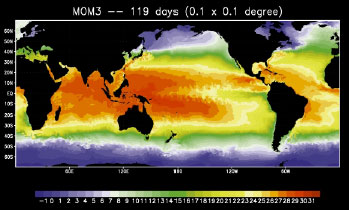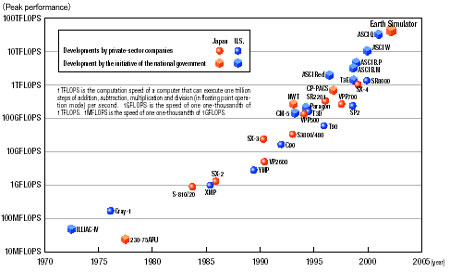Ocean Newsletter
No.36 February 5, 2002
-
Saving a Life and Teaching about Life Raison d'etre of lifesaving
Chikara KOMINE Director general, Japan Lifesaving Association, Specified Nonprofit Corporation, Cabinet Office
Taking the element required in actual lifesaving in sporting events into account, a spirit of "respect for life" not the supreme victory seen in many sports is given priority in lifesaving sport. The raison d'etre of lifesaving is in teaching about "life", the theme which man keeps questioning the most.
-
Conduct Pioneering Researches to Elucidate and Predict the Ocean Global Circulation! - The Fastest Computer in the World Performs Large-Scale Simulations -
Hiroshi MATSUOKA Deputy chief of the Earth Simulator Development Team of Japan Atomic Energy Research InstituteChief of the system management group of Earth Simulator Center, Japan Marine Science and Technology Center / Selected Papers No.3(p.16)
Global warming is generated as a result of the complicated interaction of various global phenomena. In predicting that, large-scale simulation is necessary to compute in parallel with distinctly various processes such as the atmosphere and ocean circulation. The fastest supercomputer in the world is here in Japan. There is a need for the "Earth Simulator" to be used and to make more breakthroughs.
Selected Papers No.3(p.16) -
Hoping for a Bright Future in Marine Structures
Jitsuzo NAGAO Vice Chairman, Marine Traffic System Forum
I believe that "A Lesson from Aquapolis" (Newsletter 32nd edition) must be born in mind as a fundamental issue for those involved in ocean development. However, please don't leave a bad impression of marine structures wholly by posteriori reasoning. Why not reexamine the practical use of future marine structures based on reflection on the past as a requiem of Aquapolis?
Conduct Pioneering Researches to Elucidate and Predict the Ocean Global Circulation! - The Fastest Computer in the World Performs Large-Scale Simulations -
Global warming is generated as a result of the complicated interaction of various global phenomena. In predicting that, large-scale simulation is necessary to compute in parallel with distinctly various processes such as the atmosphere and ocean circulation. The fastest supercomputer in the world is here in Japan. There is a need for the "Earth Simulator" to be used and to make more breakthroughs.
Prediction of global warming phenomena and supercomputers
The existence of mankind is endangered if we cannot predict the complex effects of global warming on the ocean and take appropriate countermeasures in advance. Prediction of the effects, however, is a very tough task to tackle.
Global warming occurs as a result of complicated interactions of various large-scale phenomena. To predict the effects of global warming, large-scale simulations must be performed. Through such simulations, the circulation in atmospheric air and the ocean, iceberg effects, chemical reactions of CO2, changes in the ecosystems of forests, plankton, and a great diversity of other natural processes must be computed simultaneously. To predict the effects of global warming accurately, the capacity of currently available supercomputers is far less than the required capacity level; a computation speed far greater than the speed of supercomputers is required to perform such largescale simulations.
A large-scale simulation program starts to run.
A world ocean map colorfully depicting the oceanographic state of the ocean was put up on the wall of the Earth Simulator Research and Development Center 1) where I work. It represents the results of computations that a supercomputer called the "Earth Simulator" performed to simulate the temperatures of the surfaces of the ocean during the period of four months starting on January 1st in a certain typical year. (see Figure 1) An ocean global circulation simulation program called MOM3 was used to run the supercomputer. Because modifications and improvements to this program were made during the simulation to allow it to operate efficiently on the Earth Simulator, the results shown on the map are not significant in terms of scientific accuracy. It should be noted, however, that a large number of data points are established on the ocean, and data are processed and plotted in ultrafine meshes of 0.1 degrees in both latitudinal and longitudinal directions.
 Fig.1 Results of the ocean global circulation simulations (December 2001)
Fig.1 Results of the ocean global circulation simulations (December 2001)
We have here the world's fastest computer in Japan.
The Earth Simulator is the world's fastest supercomputer capable of executing 40 trillion steps of addition, subtraction, multiplication and division per second. It was conceived and developed by Mr. Miyoshi, who was the general manager of the Earth Simulator Research and Development Center. It will be completed soon and start operation in March for users who do research to predict changes in the global environment.
The history of the development of supercomputers in the world has been a development competition between Japan and the U.S. In Japan Mr. Miyoshi was always playing the leading role in developing vector computers and accomplished a great achievement of increasing the computation speed 2.5 million times as fast after enhancing the computer capability in a number of development stages.
Carry out the intention of Mr. Miyoshi, who always pursued high ideals!
Regrettably, Mr. Miyoshi passed away in November last year.
When he was in the hospital, he often said, "The Earth Simulator is merely a box if it is idle. Using such a largescale vector parallel computer will be a new experience for both the operator and the user. Two to three years from now are a very important period. As the operator, you must think from scratch and develop an efficient operating method. Support the user with the mindset that you educate and raise Japanese user groups who can make a worldclass contribution. This is the mission that you at the Earth Simulator Center 2) must accomplish."
Now is the time when the operator and user of the Earth Simulator bring their wisdom together and cooperate closely. I hope that the application software suitable for the world's fastest computer system developed by Mr. Miyoshi will be developed and introduced to the world from here. We must carry out the project to provide the operator and the user with the motivation and the will to develop such application software and introduce the true power of the Earth Simulator to the world.
Work together beyond the framework of each organization to realize an ideal science plan now!
Should true researchers devote themselves only to writing papers? Asked this question, I find it difficult to give a clear answer. If researchers called to a project site have a very high academic level, each researcher wants to be the first to announce a research paper to the world and gives the highest priority to writing his or her own research papers. I suppose that there are few researchers who have the motivation and latitude to take serious interest in achieving a project goal. On the other hand, a national government responsible for managing the progress of a project does the best to acquire a budget when proposing or starting the project, but the interest in the project that has entered an operation stage wanes off quickly as new projects emerge every year and there are changes in the personnel. To make a project successful by preventing such a situation, it is necessary to gather the people who can perceive the achievement of a project goal as one of the important goals in their life and maintain a strong will to pursue the goal (loyalty to a project). The framework of organizations does not exist; the only thing that exists for them is the science plan (research target) to be carried out.
I also hope that the people who have been playing the world's leading role in the field of collection and analysis of oceanic data use the Earth Simulator to accomplish even higher research goals.
 History of the development of supercomputers in the world (trends in the increase of computation speeds)
History of the development of supercomputers in the world (trends in the increase of computation speeds)
- The Earth Simulator Research and Development Center was jointly established by the National Space Development Agency of Japan, Japan Atomic Energy Research Institute and Japan Marine Science and Technology Center to develop the Earth Simulator, a super-high-speed parallel computer system, as part of the earth simulator project that the Science and Technology Agency (present Ministry of Education, Culture, Sports, Science and Technology) undertook in 1997.
- The Earth Simulator Center is the computer operation center that was established in the Japan Marine Science and Technology Center in April 2001 to operate the Earth Simulator. Preparations are being made to start operation in March 2002.
